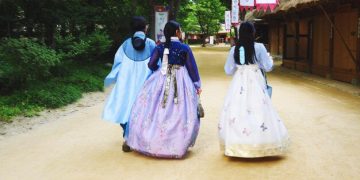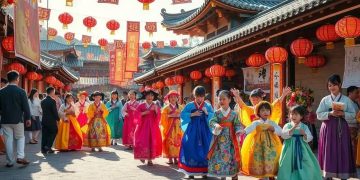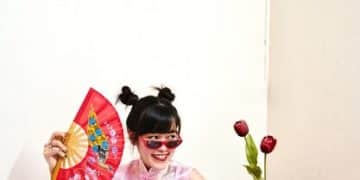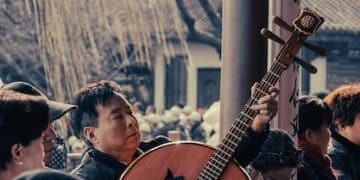Korean Holidays & Festivals in the US: Celebrate Korean Culture
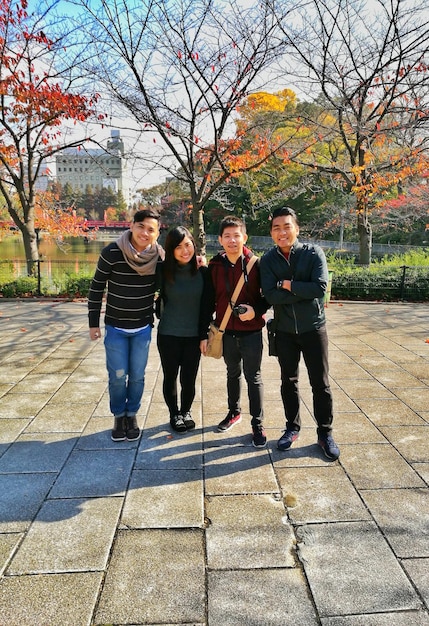
Korean Holidays and Festivals in the US: A Guide to Celebrating Korean Culture provides an overview of major Korean celebrations observed in the United States, highlighting their unique cultural significance and how Korean-Americans preserve their heritage.
Celebrating cultural diversity is a hallmark of the United States, and the vibrant traditions of Korean-Americans contribute significantly to this rich tapestry. This guide explores **Korean Holidays and Festivals in the US: A Guide to Celebrating Korean Culture**, showcasing the unique customs and events that keep the Korean spirit alive across the nation.
Exploring Korean Holidays and Festivals in the US
The United States is home to a large and dynamic Korean diaspora, and with it comes a vivid array of holidays and festivals that reflect the preservation and celebration of their cultural heritage. These events are essential for fostering community, maintaining cultural identity, and sharing Korean traditions with a broader American audience.
This guide aims to provide a comprehensive look at some of the most significant Korean holidays and festivals observed in the US, highlighting the traditions, foods, and activities associated with each.
Seollal: Korean Lunar New Year
Seollal, the Korean Lunar New Year, is one of the most important holidays in Korea and among Korean communities worldwide. It’s a time for honoring ancestors, family gatherings, and traditional Korean games.
- Charye: Ancestral rites performed to honor deceased family members.
- Sebae: Younger generations perform a deep traditional bow to elders, receiving blessings and money in return.
- Tteokguk: Eating a bowl of this rice cake soup symbolizes gaining another year of age and good fortune.
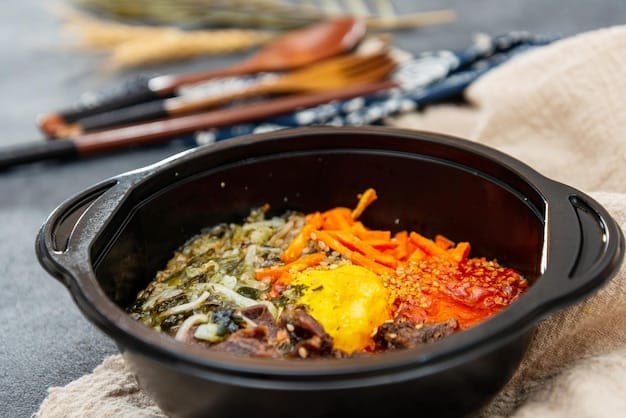
In the US, Korean-American families often maintain these traditions, gathering to celebrate Seollal with traditional foods, games, and family activities. Many Korean cultural centers and organizations also host Seollal events that are available to the broader community, celebrating Korean culture.
Seollal is a vital cultural touchstone for Korean-Americans, linking them to their heritage and providing a chance to share their traditions with others.
Celebrating Chuseok: Korean Thanksgiving
Chuseok, often referred to as Korean Thanksgiving, is a major harvest festival celebrated on the 15th day of the 8th month of the lunar calendar. It is a time to give thanks for the year’s harvest and to honor ancestors.
This holiday is marked by several unique customs and traditional foods, offering a glimpse into Korean cultural heritage.
Key Chuseok Traditions
Chuseok observances are rooted in both agricultural and ancestral veneration. The holiday emphasizes the interconnectedness between past, present, and future.
- Visiting Ancestral Graves: Families visit and tend to the graves of their ancestors, offering food and paying respects.
- Beolcho: The practice of clearing weeds and tidying up ancestral graves.
- Songpyeon: Making and eating these small, half-moon-shaped rice cakes filled with sweet fillings such as sesame seeds, beans, and chestnuts.

Korean-Americans often celebrate Chuseok with family gatherings, traditional meals, and cultural events. Many community organizations host festivals featuring Korean food, music, and dance, providing non-Koreans with an opportunity to learn about and appreciate Korean culture. Chuseok is an important opportunity for cultural sharing and community building among Korean-Americans in the US.
Chuseok is a cherished holiday that encapsulates the importance of gratitude, family, and cultural preservation among Korean-Americans.
The Significance of Dano: Korean Spring Festival
Dano, also known as the Korean Spring Festival, is a traditional holiday celebrated on the fifth day of the fifth month of the lunar calendar. It marks the transition from spring to summer and is filled with unique customs, traditions, and foods.
Dano is primarily associated with agricultural rituals and folk games, blending shamanistic traditions.
Traditional Dano Practices
Several practices during Dano are intended to celebrate the advent of warmer weather and ensure a bountiful harvest.
- Changpo (Sweet Flag) Washing: Women traditionally wash their hair in water infused with sweet flag to add shine and believed to ward off evil spirits.
- Ssireum (Korean Wrestling): A classic sport often played during Dano, with the winner receiving prizes like rice or a calf.
- Danoje Festivals: Events featuring traditional music, dance, and folk games, often held in towns and villages throughout Korea.
While Dano is less widely celebrated among Korean-Americans compared to Seollal or Chuseok, efforts are still made to keep the traditions of Korean holidays alive through cultural organizations and community events. Some Korean-American communities host small Dano celebrations, featuring traditional games, Korean foods, and cultural exhibitions. Dano demonstrates the continuity of Korean traditions across different countries and generations.
Dano remains a vibrant reminder of Korea’s rich cultural past and the deep connection between its people and the land.
Buddha’s Birthday (Seokga Tansinil): Celebrating Enlightenment
Buddha’s Birthday, known as Seokga Tansinil in Korean, is an important holiday celebrated on the eighth day of the fourth month of the lunar calendar. It commemorates the birth of Siddhartha Gautama, the founder of Buddhism.
This holiday is marked by a number of colorful and deeply spiritual practices.
Central Seokga Tansinil Rituals
Seokga Tansinil is characterized by acts of worship, lighting of lanterns, and community meals, symbolizing enlightenment and compassion.
- Lantern Lighting: Temples and homes are decorated with colorful paper lanterns, symbolizing the illumination of wisdom.
- Temple Visits: Worshippers visit temples to offer prayers and participate in ceremonies.
- Free Meals: Many temples provide free meals of bibimbap and other vegetarian dishes to visitors.
In the US, Buddha’s Birthday is celebrated by Korean Buddhist communities in temples and cultural centers. Festivities often include traditional music, dance, and cultural displays alongside religious observances. These celebrations provide a glimpse into Korean Buddhism and help promote cultural understanding among Korean-Americans. Seokga Tansinil is seen as an opportunity for spiritual reflection.
Buddha’s Birthday is a significant occasion for Korean Buddhists, fostering unity, peace, and cultural pride within the community and beyond.
Korean Independence Day: Remembering National Pride
Korean Independence Day, known as Gwangbokjeol, is celebrated annually on August 15th. It commemorates Korea’s liberation from Japanese colonial rule in 1945.
This holiday is a time for Koreans worldwide to reflect on their nation’s history, celebrate their freedom.
Historical Context and Modern Celebrations
Gwangbokjeol is a day of national pride and remembrance, often marked with significant events and commemorations.
- Flag Raising: A Korean flag raising ceremony is held to honor the patriots who fought for independence.
- Speeches and Performances: Commemorative speeches and cultural performances highlighting Korean history and culture take place.
- Museum Visits: Many Koreans visit historical sites and museums to learn more about their nation’s past.
For Korean-Americans, Gwangbokjeol is an opportunity to celebrate their heritage and reflect on the history of their parents’ or grandparents’ homeland. Cultural organizations and community groups often host events to commemorate the day, featuring Korean music, dance, and educational presentations about Korean history. Communities gather together to celebrate the rich Korean culture and share it with others. This holiday is an opportunity to promote understanding and appreciation of Korean heritage among all Americans.
Gwangbokjeol serves as a poignant reminder of the resilience and determination of the Korean people, and it strengthens the bond between Korean-Americans and their ancestral homeland.
Sharing and Preserving Korean Culture in the US
Korean holidays and festivals celebrated in the US are more than just dates on a calendar – they are dynamic expressions of cultural identity, history, and community. Korean-Americans actively work to preserve these traditions and share them with a broader audience.
From organizing large-scale community events to teaching traditional customs to younger generations, Korean-Americans are committed to keeping their vibrant culture alive.
Ways to Engage with Korean Culture
There are numerous ways to participate in and support Korean cultural events in the US, from attending festivals to volunteering with community organizations.
- Attend Local Events: Look for Korean cultural festivals, performances, and exhibitions in your area.
- Support Korean Businesses: Visit Korean restaurants, shops, and cultural centers to support the local Korean community.
- Learn Korean Language and Culture: Take language classes or cultural workshops to gain a deeper understanding of Korean traditions.
In addition to formal events, community-led initiatives and neighborhood cultural activities allow more people to experience authentic Korean festivals. Preserving and sharing Korean culture not only strengthens communal bonds but also enriches the diversity of American life. Through engagement, advocacy, and education, Korean-Americans play a crucial and ongoing role in promoting their culture within the US.
The preservation and celebration of Korean culture in the US serve as a testament to the resilience and vibrancy of the Korean-American community.
| Key Point | Brief Description |
|---|---|
| 🎉 Seollal | Korean Lunar New Year celebrated with ancestral rites and family gatherings. |
| 🍂 Chuseok | Korean Thanksgiving, a harvest festival honoring ancestors with traditional foods. |
| 🌸 Dano | Korean Spring Festival marking the transition from spring to summer, with folk games. |
| 🇰🇷 Gwangbokjeol | Korean Independence Day commemorating liberation from Japanese colonial rule. |
Frequently Asked Questions
▼
Seollal is the Korean Lunar New Year, one of the most significant traditional holidays in Korea. It involves honoring ancestors, family gatherings, and enjoying traditional Korean cuisine.
▼
Chuseok, also known as Korean Thanksgiving, is a major harvest festival celebrated on the 15th day of the 8th month of the lunar calendar. It is a time to give thanks for the year’s harvest.
▼
Buddha’s Birthday celebrations in the US often include visits to temples, colorful lantern displays, traditional music, and communal meals, reflecting both religious and cultural traditions.
▼
Korean Independence Day is celebrated with flag-raising ceremonies, commemorative speeches, cultural performances, and visits to historical sites.
▼
You can get involved by attending local Korean cultural festivals, supporting Korean businesses, taking language and culture classes, and volunteering with local Korean community organizations.
Conclusion
Korean holidays and festivals in the US provide a rich cultural landscape for both Korean-Americans and those interested in learning more about Korean traditions. From Lunar New Year celebrations to harvest festivals and independence commemorations, these events offer a vibrant glimpse into a culture that continues to thrive and evolve within the American context.

